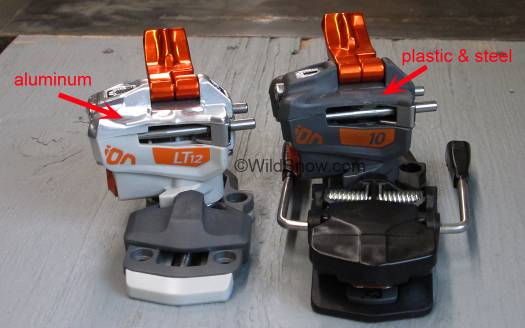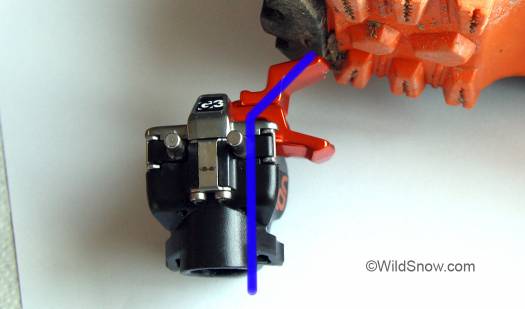
ION ski touring bindings for 2015-2016, left to right LT12, ION 10, ION 12. Note red toe springs on ION 10, and plastic heel unit cap on models 10-12. Later manufacturing runs of the LT12 will have the plastic heel cap as well.
The 2015-2016 ION ski touring binding is nearly identical to 2014 model 12, with the addition of a 12 without brake (LT12) and a release value 10 model. Sightseeing tour reveals red painted toe spring on model 10, and the change from solid aluminum to a plastic-steel “co-molded” heel top plate on models 10-12. LT12 continues with the beautiful aluminum top plate used on model 12 last season.
I asked G3 about the red spring. Word is it’s of different strength for the version 10 binding, and colored to prevent confusion. We like that. A lot. We’ve always been unclear about which parts can be interchanged with various versions of tech ski touring bindings, so nice to get clarity. This sort of thing demonstrates the thoughtful attention to detail we get from G3 backcountry binding engineering. Another example is all ION adjustments use the same screwdriver; just rack or carry a pozidrive 2 and you’re 99.9% covered; for total upkeep (top plate screws and hidden screws under heel base) add in a T10 star drive.
It’s worth calling G3 out on their mounting instructions. Stellar. Clean. Simple. With practical advice such as mentioning using waterproof adhesive for binding holes with this note: “Using slow cure epoxy significantly increases mounting strength and is recommended if you are an aggressive or heavy skier, if you commonly carry a loaded pack, or if you use wide skis.”
Above epoxy voodoo is verified from careful testing by a G3 engineer, not just guesswork. Along with the glue recommendation, bear in mind that ION has a significantly wider toe-unit base and screw hole pattern than traditional tech bindings (heel base has slightly wider screw pattern). In our experience binding mount width is inconsequential for skis around 100 mm or under, but if you like huge planks or ski like you’re at war, a wider binding platform is common sense.

Last season ION had the confidence-inspiring aluminum heel unit top plate, which will remain on LT12, but the 10-12 models will have a co-molded plastic-steel top plate. We suspect the new part is at least as strong, perhaps stronger, but in my superior aesthetic judgment doesn’t look as good. I spoke with the G3 binding engineer; he said the new heel unit cap is indeed stronger than the aluminum, and mentioned that the brake base is also plastic now instead of aluminum. A single ION is 2 grams lighter as a result, and the binding is said to be less prone to icing in the brake plate area due to the use of plastic instead of aluminum.
Our favorite thing about ION is the toe’s strong clamping power, due to a subtle change in geometry from traditional tech binding toe design. Testing last winter revealed a binding that is nothing less than bomber with a thick top plate on the heel unit fixed by large machine screws inserted from the bottom. Only glitch I and other testers noticed was the brake sometimes deploying while locked in touring mode. We suspect that bug is quashed, but more field testing will be necessary to verify.
In downhill mode the binding heel slides fore/aft to absorb ski flex, but locks solidly when twisted to touring mode. This prevents wear and disconcerting movement of the heel when you’re climbing. The brakes (ski stoppers) are impressive — super strong springs and thick arms. (Brakes are not removable, but we suspect brake arms can be swapped for different ski widths.)

G3 ION has heel lifter “line of force” similar to other bindings with flipping heel lifters; thankfully field testing and bench evaluation show it to be very strong. We don’t anticipate any top plate weakness with ION, and have heard no reports of such from last winter. Readers, please email reports using contact link in menu above.

All ION top plate fasteners insert from the bottom, and top plate is firmly nested on housing and integrated with a steel front lip that interfaces with the boot’s steel tech fitting (the lip is mated to the top plate with the screws rather than being an integral part of top plate).

Check out the machinery that enables spring loaded compensation for ski flex. Every binding has a serial number so any problems can be easily tracked — customers and dealers can quickly ascertain vintage.
Weights obtained from retail-ready ION 2015-2016 ski bindings we received at WildSnow HQ a few days ago.
ION 10 and 12, with screws and 100 mm brake, total single binding 21.7 ounces, 615 grams (screws, 23 grams).
ION 10 heel, no screws, 14.9 ounces, 422 grams.
ION 10 toe, no screws, 6.2 ounces, 176 grams.
ION LT12, with screws, total single binding, has no brake: 17 ounces, 480 grams.
ION LT12 heel, no screws: 10.1 ounces, 286 grams.
ION LT12 toe, no screws: 6.1 ounces, 170 grams (weight probably reduced by lack of boot location tabs).
Shop for G3 ION ski touring bindings
Available brake widths are 85-100-115-130, and the available crampons are awesome (Lisa tested them extensively last spring.)
WildSnow.com publisher emeritus and founder Lou (Louis Dawson) has a 50+ years career in climbing, backcountry skiing and ski mountaineering. He was the first person in history to ski down all 54 Colorado 14,000-foot peaks, has authored numerous books about about backcountry skiing, and has skied from the summit of Denali in Alaska, North America’s highest mountain.

